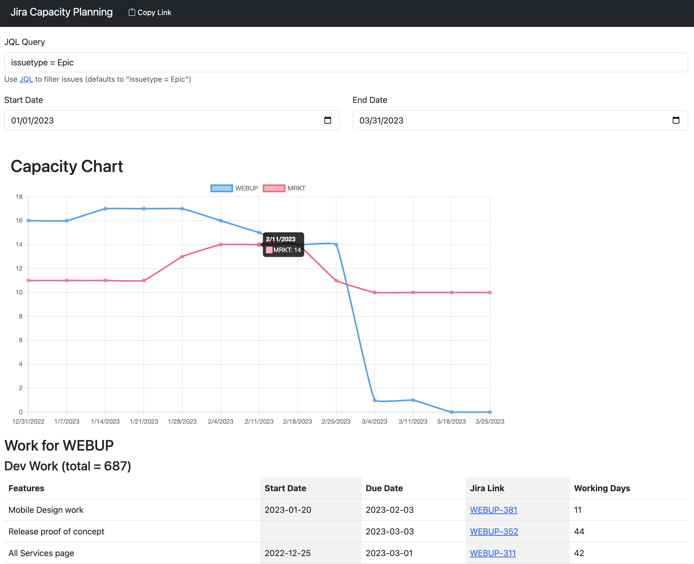Do you often find yourself shuffling between Jira boards and calendars, hoping this sprint, you’ll get the workload balance right? TPOs and Scrum Masters managing multiple teams know the struggle all too well. It’s difficult to know whether a team is at capacity until they’ve already exceeded it.
Enter the Jira Capacity Report, a tool that allows you to quickly visualize the workload of your teams based on epics in your Jira space.
The Jira Capacity Report is a browser app we developed for an internal need to quickly view the workload of multiple teams. Our Jira Capacity Report tool makes it easier to plan sprints for complex projects, and we think it’s too valuable not to share.
This tool might be a good fit for you if:
-
You use due dates on epics (or custom issue types like initiatives).
-
You use JIRA for something like PI planning—especially the Epic scheduling/timeline view.
-
You want to know whether the work scheduled needs to be adjusted based on the load of each team.
First, navigate to the Jira Capacity Report Tool and authenticate with your Jira instance. This is just a browser app, and we do not save any of your information on our servers once you have authenticated, per our privacy policy.
By default, the tool will fetch all epics in your Jira space and show you a timeline of how much work is in-flight per team based on epics.

On the chart, an epic is considered to be ongoing during a week if it began before or during that week AND ends during or after that week.
If you want to look at a different set of stories, you can use JQL (Jira Query Language). We've included a few examples of JQL strings below to get you started:
-
issuetype = Epic AND status = "In Progress": Shows all epics that are currently in progress
-
issuetype = Epic AND project = "Project X": Shows all epics associated with a specific project
-
issuetype = Epic AND assignee = currentUser(): Shows all epics that are assigned to the current user
To look at a different span of time, you can update the date range inputs (which default to the current calendar quarter). The dates and JQL, if changed from the default, will update the query string in the URL. This means you can bookmark the current view or use the "copy link" button at the top of the page to share the URL with anyone who can authenticate with your Jira instance.
Contributing to Jira Capacity Report
We're always looking for ways to improve the Jira Capacity Report tool and make it more useful for our users. If you have any feedback or feature requests, please contact us through our Community Discord or by opening an issue on our GitHub repository.
In addition to giving feedback, there are a few ways you can contribute to the project:
-
Contribute to the codebase: The Jira Capacity Report tool is open source and hosted on GitHub. You can find the codebase in the bitovi/Jira-capacity-report repository.
-
Use the template: We've also created a template for creating similar tools. You can find it in the bitovi/Jira-capacity-template repository.
-
Help us create more tools: Based on feedback, we're always looking to create more tools that make it easier for teams to work together in Jira. If you have an idea for a tool, let us know, and we'll see if it's something we can build together.
Conclusion
The Jira Capacity Report tool is a great tool for TPOs/PMs doing PI planning or long-term program planning. It lets you quickly see which teams might be overloaded so work can be rearranged and/or reprioritized.
Need More Help?
Drop into Bitovi’s Community Discord, and talk to us in the agile-delivery-management forum!
Never miss an update!
Subscribe to the blog 📬
